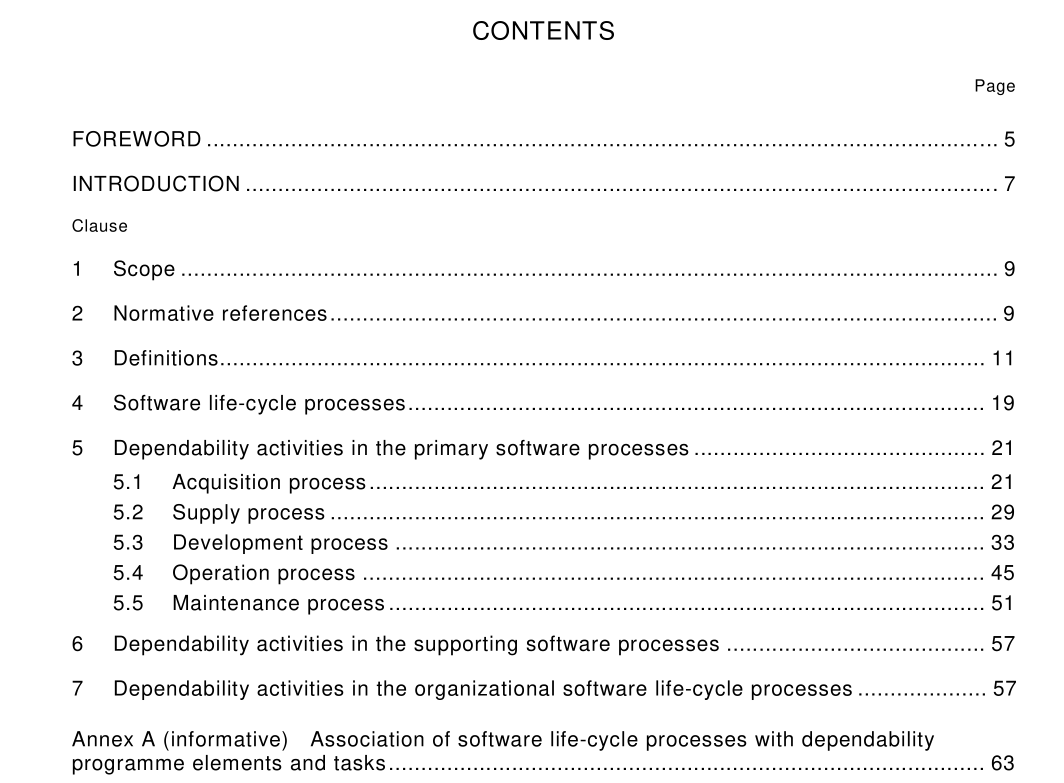IEC 61713 pdf download

IEC 61713 pdf download.Software dependability through the software life-cycle processes – Application guide
1 Scope
This International Standard provides guidance on those aspects of software life-cycle activities that have a bearing on the achievement of dependable software. The software life- cycle activities are defined in the context of software life-cycle processes. This guide is intended to be used to support IEC 60300-3-6. The software life-cycle activities identified can be part of a dependability programme for a system or in relation to a product containing software. The activities identified will help achieve software that is reliable and maintainable and help ensure that appropriate maintenance support will be provided. The activities can be applicable throughout the entire software life cycle or be limited to a subset of the software life-cycle processes depending upon the users of the software. The relationship between the users of the software and the software life-cycle processes is shown in annex B. They are grouped according to the various individual software life-cycle processes that represent the overall software life-cycle as defined in ISO/IEC 1 2207. Emphasis is placed on the dependability requirements and activities applicable in the primary software life-cycle processes. This guide can be used by acquirers, suppliers, developers, operators or maintainers of software. In addition to software and dependability specialists, this guide is intended for use by project managers, quality practitioners and other project participants who develop or use systems or products containing software.
3 Definitions
For the purpose of this International Standard, the terms and definitions of IEC 60050(1 91 ), ISO/IEC 1 2207 and ISO 8402 apply together with the following. 3.1 dependability collective term used to describe the availability performance and its influencing factors: reliability performance, maintainability performance and maintenance support performance. [IEV 1 91 -02-03] NOTE Software dependability will be described in terms of software reliability, software maintainability and software maintenance support. 3.2 dependability function term used to describe an individual aspect of the software dependability requirement speci- fication. The dependability function can describe reliability, maintainability or maintenance support-related dependability requirements 3.3 maintenance release product release which is carried out for corrective maintenance rather than to provide enhanced functionality 3.4 software reliability probability that no fault in any software element of a system will be activated in a given time interval in the operation of the system under given conditions 3.5 software maintainability ease with which a detected fault in a software element of a system can be corrected 3.6 software maintenance support ability of an organization, under given conditions, to provide upon demand the resources required to maintain a software element of a system, under a given maintenance policy NOTE The given conditions are related to the software element itself and to the conditions under which it is used and maintained. [IEV 1 91 -02-08, modified] To assist understanding of this standard, the following definitions of terms used in ISO/IEC 1 2207 are repeated here. 3.7 acquirer organization that acquires or procures a system, software product or software service from a supplier NOTE The acquirer could be one of the following: buyer, customer, owner, user, purchaser. 3.8 acquisition process of obtaining a system, software product or software service 3.9 agreement definition of terms and conditions under which a working relationship will be conducted 3.1 0 audit conducted by an authorized person for the purpose of providing an independent assessment of software products and processes in order to assess compliance with requirements 3.1 1 baseline formally approved version of a configuration item, regardless of media, formally designated and fixed at a specific time during the configuration item’s life cycle 3.1 2 configuration item entity within a configuration that satisfies an end-use function and that can be uniquely identified at a given reference point 3.1 3 contract binding agreement between two parties, especially enforceable by law, or a similar internal agreement wholly within an organization, for the supply of software service or for the supply, development, production, operation, or maintenance of a software product 3.1 4 developer organization that performs development activities (including requirements analysis, design, testing through acceptance) during the software life-cycle process 3.1 5 evaluation systematic determination of the extent to which an entity meets its specified criteria 3.1 6 firmware combination of a hardware device and computer instructions or computer data that reside as read-only software on the hardware device. The software cannot be readily modified under program control









